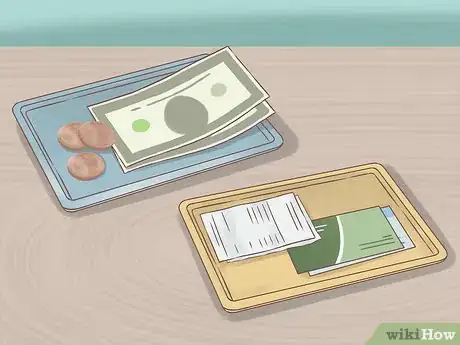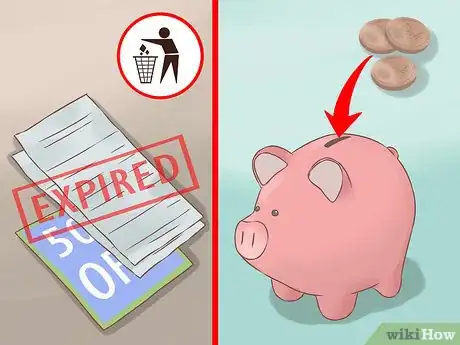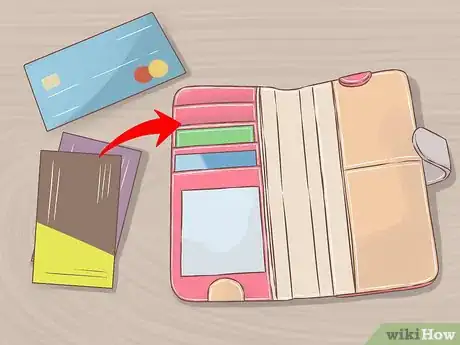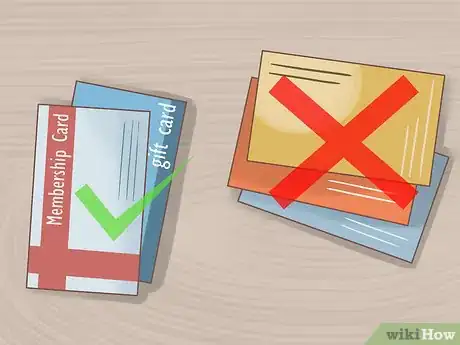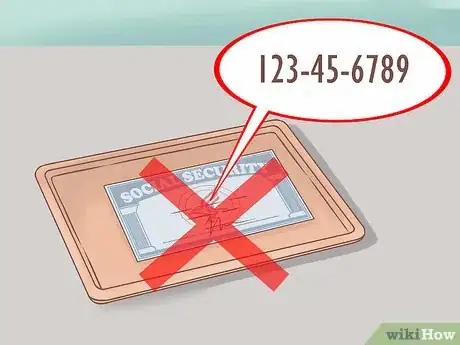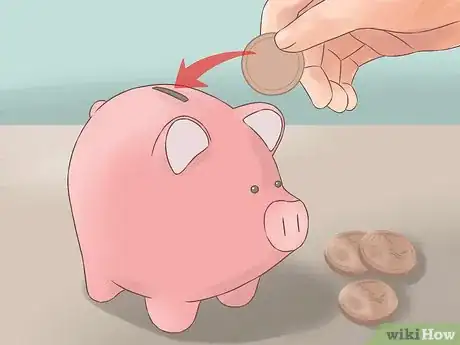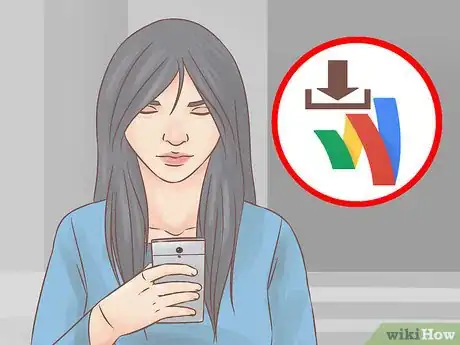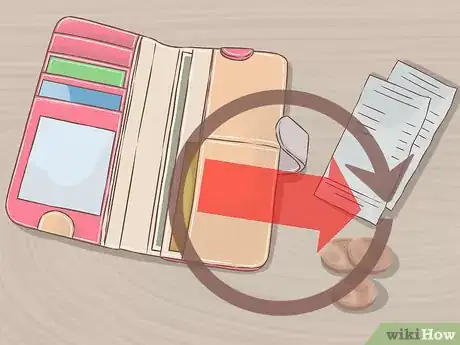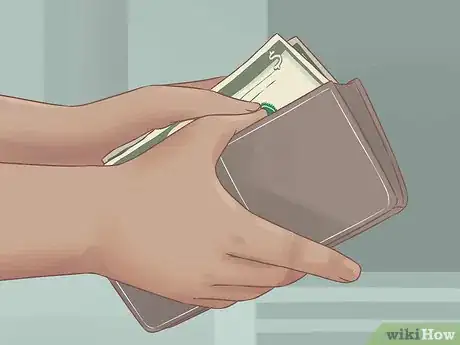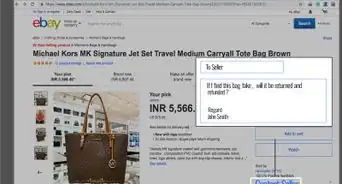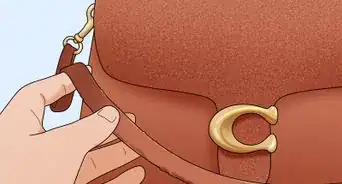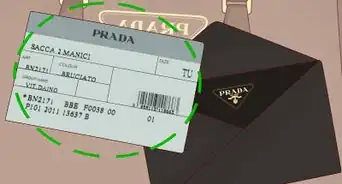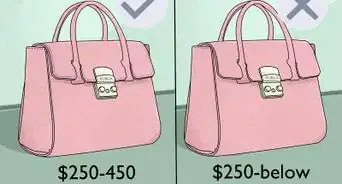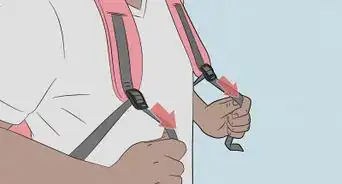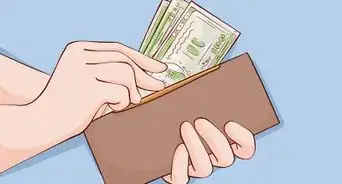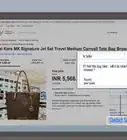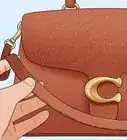This article was co-authored by wikiHow Staff. Our trained team of editors and researchers validate articles for accuracy and comprehensiveness. wikiHow's Content Management Team carefully monitors the work from our editorial staff to ensure that each article is backed by trusted research and meets our high quality standards.
This article has been viewed 75,042 times.
Learn more...
Organizing a wallet can be a daunting task given the number of cards, receipts, and other items that can accumulate over time. Start by emptying out your wallet completely, separating things, and replacing all the necessary and priority cards into your wallet. Remove unnecessary items like small change and business cards, and leave your social security card at home. To prevent future clutter, avoid keeping receipts in your wallet, download a helpful smartphone app, and clean out your wallet regularly.
Steps
Separating Contents
-
1Empty out your wallet. Remove all of the contents of your wallet. Lay them out on a table in front of you. Make sure to look in every fold and pocket for small items like spare change, crumpled receipts or subway tokens.[1]
-
2Separate items. Separate your cash, cards, receipts, coupons, and other wallet contents into piles. Place rewards cards and gift cards in their own pile. Separate cash bills by denomination.[2]Advertisement
-
3Discard unnecessary items. Discard receipts that are more than 90 days old, as well as expired coupons. Remove any wallet inserts that are not needed. Place coins in a jar or piggy bank to save up and deposit in the bank at a later date.[3]
-
4Replace items. Remove the cards you need the most (e.g. bank and credits cards, ID cards) from their pile and place them back in your wallet. Organize them in the most easily accessible card holders in your wallet, according to which you use most. Keep your health insurance card in an easily accessible slot as well in case of emergency.[4]
-
5Reinsert cash. Straighten out your cash bills. Place them in your wallet fold, lengthwise. Keep smaller bills towards the front to keep your cash organized.[5]
-
6Choose secondary cards to keep. Decide what secondary cards you'd like to have on hand. These cards might include membership cards (e.g. library, gym), gift cards you intend to use soon, insurance cards, and rewards cards. Be sure to only choose as many cards as the card holders in your wallet can accommodate; leave the rest in a safe spot at home.[6]
Removing Unnecessary Items
-
1Leave your social security card out. Make sure to leave your Social Security card out of your wallet and safely tucked away at home. Carrying it with you can leave you vulnerable to identity theft, which could result in a thief opening credit cards, taking out a loan, or making large purchases. To be safe, simply memorize the nine digit number.[7]
-
2Take out business cards. Remove any business cards that you've collected in your wallet. Sort through them; enter the information you wish to keep in your phone or agenda, or take photos of them to store digitally. Discard the cards.[8]
-
3Remove small change. Lighten up your wallet by removing small change from it. Place coins in a jar or piggy bank at home. Leave bills and larger coins in your wallet.[9]
Preventing Future Clutter
-
1Keep receipts out of your wallet. Throw out any receipts for something you have already consumed (e.g. a fast food meal). Avoid placing receipts in your wallet; keep them in a separate pouch or wallet. To keep them from getting crumpled or torn, bring them home to file away, or to scan and store digitally.[10]
-
2Download helpful apps. There are apps available that can help you keep your wallet clear and clutter-free. These apps can allow you to transfer money, consolidate your loyalty and rewards cards digitally, and store your bank and debit cards, making it unnecessary to keep them all in your wallet. Try downloading one of these notable apps to simplify your spending:[11]
- Cardstar, a free app that consolidates your reward cards
- Google Wallet, an free app that allows you to transfer money to anyone with an email address and can store and consolidate most of your cards
- Key Ring, a free app that stores loyalty, membership, or library cards as well as coupons, grocery lists, and weekly store ads
-
3Clean out your wallet regularly. The best way to prevent future clutter is to clean out your wallet regularly. Remove expired coupons, used gift cards, and other items. Regularly remove small change to keep your wallet light and unencumbered. [12]
-
4Keep only a small amount of cash. It is important to keep a small amount of cash in case of emergencies, or to use at establishments that don't accept debit or credit cards. Keep this amount to a minimum; having a limited amount of cash can curb spending on small, impulse purchases. Remove small bills from your wallet every few days (e.g. aim to keep two twenty dollar bills in your wallet at all times and remove five and ten dollar bills regularly.)
- As an exception, keep extra cash in your wallet that you anticipate spending in the near future (e.g. money to use at a yard sale).
References
- ↑ http://stylecaster.com/how-to-organize-your-wallet/
- ↑ http://stylecaster.com/how-to-organize-your-wallet/
- ↑ http://stylecaster.com/how-to-organize-your-wallet/
- ↑ http://stylecaster.com/how-to-organize-your-wallet/
- ↑ http://genxfinance.com/poll-do-you-organize-the-money-in-your-wallet-or-purse/
- ↑ http://www.womansday.com/life/work-money/tips/g913/how-to-organize-your-wallet/
- ↑ http://www.realsimple.com/work-life/money/in-your-wallet/social-security-card
- ↑ http://stylecaster.com/how-to-organize-your-wallet/
- ↑ http://stylecaster.com/how-to-organize-your-wallet/

